(1) STOKER AWARDS LIVESTREAM. The Horror Writers Association will stream the Bram Stoker Awards ceremony on YouTube on April 18. Link URL in the graphic.
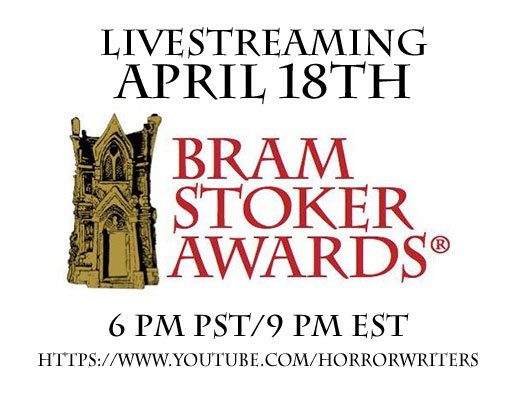
(2) DOCTOR WHO DURING LOCKDOWN. Neil Gaiman wrote “Rory’s Story” for the April 11 watchalong.
It’s 1946. Eight years after he was sent back in time by the Weeping Angels, Rory Williams is dictating his biography… ‘Rory’s Story’ was specially created as an introduction to #BiggerOnTheInside, the worldwide watchalong of the Doctor Who episode ‘The Doctor’s Wife’ , which took place online on Saturday 11 April 2020. Written by Neil Gaiman and starring Arthur Darvill as Rory, ‘Rory’s Story’ was home-produced remotely during the ‘lockdown’ period of the COVID-19 outbreak in April 2020.
(3) ICONIC ROBOTS. For a short time you can still see Eric Joyner’s collection of “Machine Man Memories” online at the Corey Helford Gallery.
Eric Joyner attended the Academy of Art and the University of San Francisco and went on to establish himself as a commercial artist, creating illustrations for Mattel Toys, Levi’s, Microsoft and Showtime. A member of San Francisco Society of Illustrators and New York Society of Illustrators, Joyner has been an instructor and speaker at San Francisco’s Academy of Art University and California College of the Arts. His work has been featured in San Jose Museum of Art’s exhibition “Robots: Evolution of a Cultural Icon”, and he has shown in numerous galleries and cultural institutions worldwide. For additional information about the artist, please visit www.ericjoyner.com.
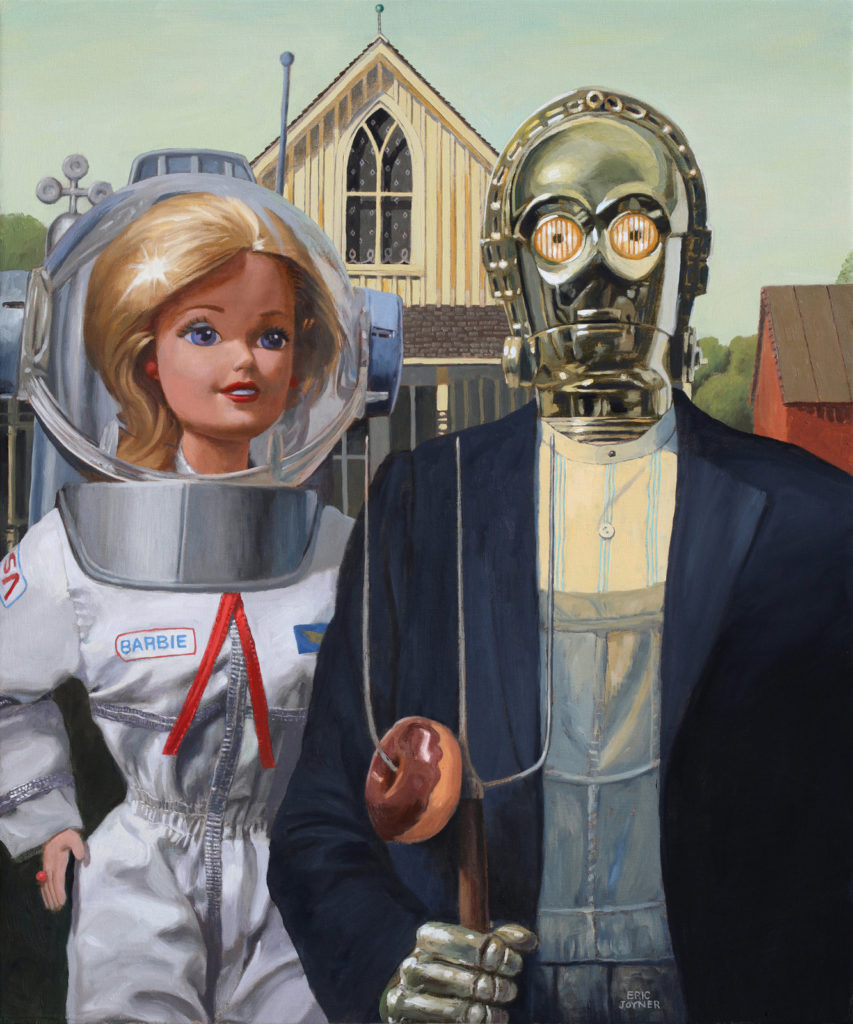
(4) HYPHENATED HISTORY. [Item by Scott Edelman.] My reread of old comics led to this ad on the back cover of House of Mystery #21 (December 1953).
The founding of this SCIENCE-FICTION BOOK CLUB is a recognition of the fact that Science-Fiction has won a place as an important *new kind* of literature — that it is a valuable addition to the library of every imaginative reader. Science-Fiction has grown so fast it’s hard to keep with it!
I wonder when they dropped the hyphen?
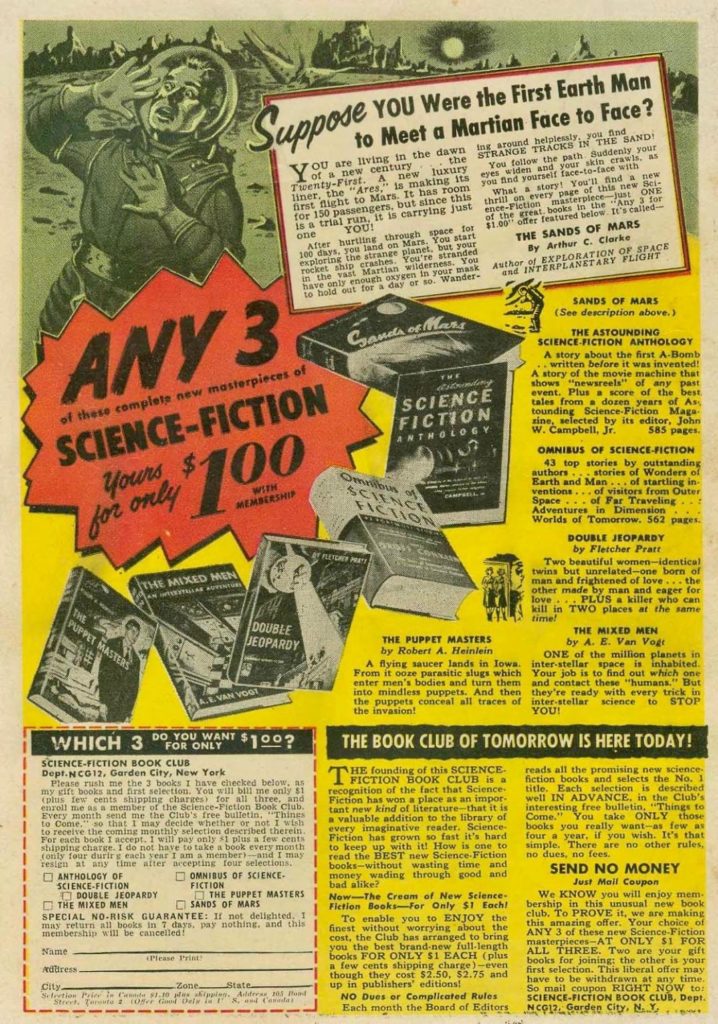
(5) STEAMPUNK RAILROAD LAYOUT. BBC reports “The steampunk model railway enthusiast having designs used by Hornby”. (Video.) These are awfully cool.
A model enthusiast has had his own steampunk designs patented by the British railway brand Hornby.
Laurie Calvert made his first model in 2012 and took the idea to Hornby the following year.
(6) BEWARE PICARD SPOILERS. The Hugo Book Club Blog thought today would be a timely occasion to discuss the theme of resurrection in sff: “The Phoenix Farce”. And did I mention, BEWARE SPOILERS!
Picard is dead for fewer than three and a half minutes of screen time. He literally spends more time saying that he will lay down his life for a cause than he spends being dead. Why should viewers get emotionally invested in Picard putting his life on the line when his life costs him nothing?
Although the finale of Star Trek: Picard’s first season provides a case example of this trend, we’d like to be clear that his pointless death and meaningless resurrection is by far not the most underwhelming. Even within the past few years of Star Trek, we’d note Dr. Hugh Culber’s resurrection in Star Trek: Discovery, and Kirk’s resurrection in Star Trek: Into Darkness.
This latter example offers an interesting comparison between resurrections of fictional characters, and what makes some more egregious than others. Into Darkness is a soft remake of The Wrath of Khan, and follows many of the same character moments: a reactor overloading, and a beloved protagonist sacrificing themselves for the greater good. In the case of The Wrath of Khan, it’s Spock who gives his life for the greater good, while in Into Darkness, it’s James Kirk. In both cases, the character who dies gets a prolonged death scene, and an emotional farewell. The narrative asks audiences to grieve for the character’s demise…
(7) DIXON OBIT. Actor Malcolm Dixon has died at the age of 66. SYFY Wire has details of his career.
…Dixon had roles in some of the most well-known fantasy and science fiction movies in the ’70s and ’80s. He was an Oompa Loompa in the legendary Willy Wonka and the Chocolate Factory. He also had roles in movies such as the cult classic Flash Gordon, Jim Henson’s Labyrinth, and Ron Howard’s Willow.
His two biggest movies were 1981’s Time Bandits, directed by Terry Gilliam. He played Strutter among an all-star cast including Sean Connery, John Cleese, and Shelley Duvall. Two years later, he played an Ewok warrior in the conclusion to the original Star Wars Trilogy, Return of the Jedi.
(8) SNOW OBIT. Condolences to Ben Bird Person, whose cat Snow (2008-2020), featured in “Cats Sleep on SFF: Barry Malzberg” just passed. She was twelve years old.
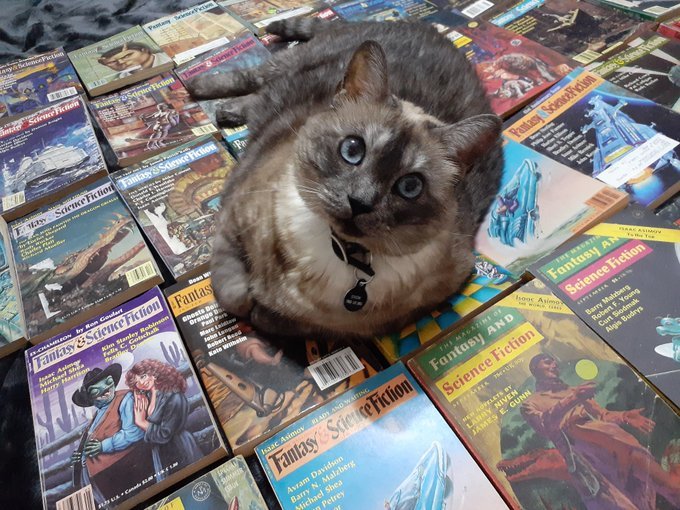
(9) TODAY IN HISTORY.
- April 12, 1940 — Black Friday premiered. It was directed by Arthur Lubin from a screenplay by Curt Siodmak (who won a Retro Hugo last year for Frankenstein Meets the Wolf Man) and Eric Taylor. Though Boris Karloff and Béla Lugosi were co-billed, Lugosi only has a rather small part in the film and does not appear on screen with Karloff. Universal Had cast Lugosi as the Doctor and Karloff as the Professor, but Karloff insisted on playing the Doctor. So Lugosi was given the minor role of a rival gangster, while Stanley Ridges was brought in to play the Professor. Reception was mixed with some critics loving the double billing, but the NYT noted that “Lugosi’s terrifying talents are wasted”. Over at Rotten Tomatoes, the audience reviewers give it a rating of 49%. It is in the the public domain now, so you can watch it here.

- April 12, 1940 — Dr. Cyclops premiered. It was produced by Dale Van Every and Merian C. Cooper, and directed by Ernest B. Schoedsack. It starred Thomas Coley, Victor Kilian, Janice Logan, Charles Halton, Frank Yaconelli, and Albert Dekker. It was written by Tom Kilpatrick from a short story by Henry Kuttner which first appeared in the June 1940 of Thrilling Wonder Stories. Critics thought it cheesy but were generally favorable in their reviews overall. Audience reviewers at Rotten Tomatoes give it a 56% rating.
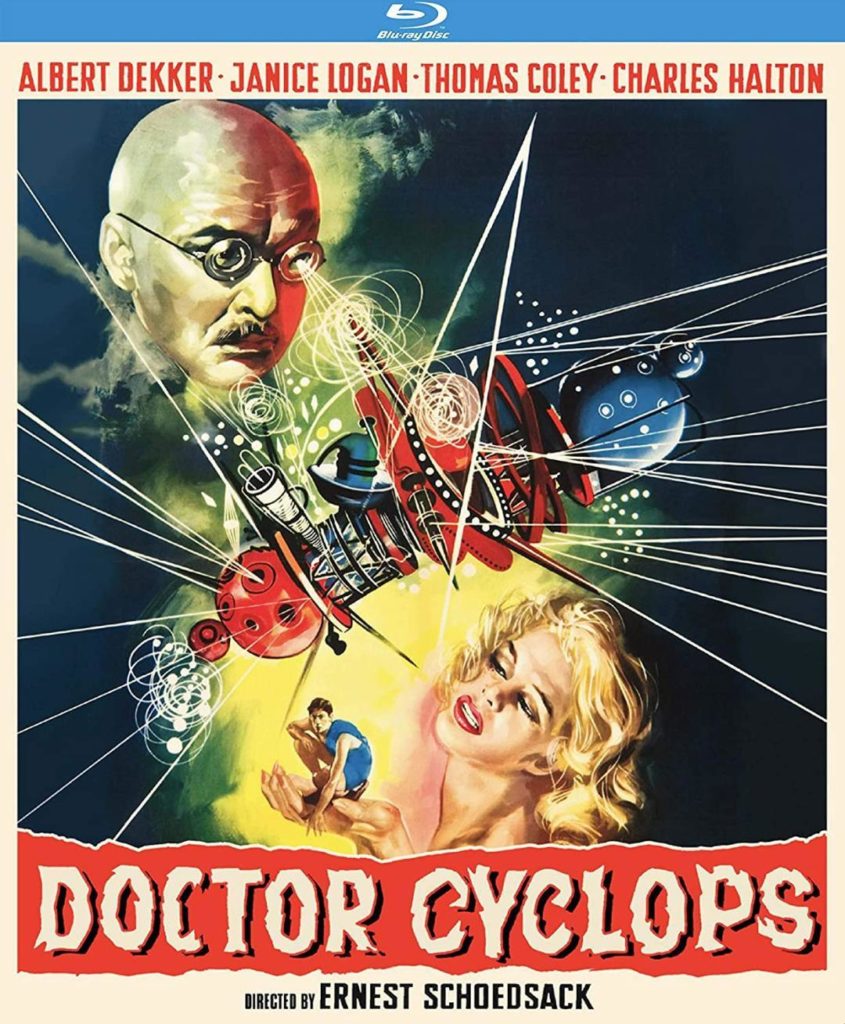
(10) TODAY’S BIRTHDAYS.
[Compiled by Cat Eldridge.]
- Born April 12, 1884 — Bob Olsen. He wrote twenty-seven poems and stories that were published in Amazing Stories in the late Twenties and early Thirties. He’s one of the first authors to use the term “space marines”. A search of both print and digital publishers does not show any indication that any of his genre or mystery fiction is now in-print. (Died 1956.)
- Born April 12, 1915 — Emil Petaja. He considered his work to be part of an older tradition of ‘weird fiction.’ He published thirteen novels and some one hundred fifty short stories. His Otava series, published by Ace Books in the Sixties, is based on the Finnish national myth, The Kalevala. (Died 2000.)
- Born April 12, 1916 — Beverly Cleary, 104. The oldest living author ever to get Birthday honors. One of America’s most successful living authors, almost a hundred million copies of her children’s books have been sold worldwide since her first book was published in seventy years ago. Some of her best known characters are Ramona Quimby and Beezus Quimby, Henry Huggins and his dog Ribsy, and Ralph S. Mouse.
- Born April 12, 1921 — Carol Emshwiller. I think her short stories are amazing and The Start of the End of It All and Other Stories collection won a World Fantasy Award. She’d later receive a Life Achievement from the group of judges chosen by the World Fantasy Awards Administration. I’ve not read her novels, so which would you recommend I read? (Died 2019.)
- Born April 12, 1922 — Vince Clarke. He first made acquaintance with fandom in the late Thirties, and was active as a fanwriter and editor from a decade hence including Science Fantasy News. He’d be the winner of the first TAFF in the early Fifties but was unable to attend. He ran the 1957 Worldcon, Loncon I, and he was Fan Guest of Honor at the 1995 Worldcon, Intersection. He’s responsible for creation of the British Science Fiction Association. (Died 1998.)
- Born April 12, 1929 — Elspet Gray. She had two great roles, first as Lady Collingford in Catweazle, a Richard Carpenter series. Second she played Chancellor Thalia in “Arc of Infinity“ a Fifth Doctor story. She also played Mrs. Dresland in The Girl in a Swing based on the Richard Adams novel. (Died 2013.)
- Born April 12, 1936 — Charles Napier. Adam in one of the worst original Trek episodes done, “The Way to Eden”. He had one-offs, and this is not a complete list, on Mission Impossible, The Incredible Hulk, Knight Rider, Tales of The Golden Monkey, The Incredible Hulk Returns, Lois & Clark: The New Adventures of Superman, Deep Space Nine and voiced Agent Zed in the animated Men in Black series. (Died 2011.)
- Born April 12, 1974 — Marley Shelton, 46. She’s been in such pulp undertakings as Sin City, Grindhouse and Scream 4, not to overlook Hercules in the Underworld and Pleasantville in which she was Margaret Henderson. She was to be Victoria Winters in the unsold Dark Shadows pilot done fifteen years ago.
(11) MASKED WISDOM. On Fast Company, “Sam Bee looks to furries to guide us through the coronavirus crisis”.
Why we care: Good ideas sometimes come from unexpected places. Consider the furry community, prone to the kink of wearing Disney World mascot-style animal costumes in public. Is it an unusual lifestyle? Absolutely. However, it just might be one that presents a path toward thriving in these antimicrobial times.
On the first episode of Full Frontal with Samantha Bee since the rapid spread of COVID-19 plunged much of America into quarantine, the hygienic wisdom of the furry community is on display. Correspondent Amy Hoggart infiltrates a furry convention that took place earlier this month to interview people who are used to wearing protective covering over their entire bodies while interacting with others.
(12) SHELL GAME. Last night on Saturday Night Live, “Middle-Aged Mutant Ninja Turtles.”
The Mutant Ninja Turtles aren’t teenagers anymore in an update of the animated series that shows how the superheroes face problems as middle-aged adults.
[Thanks to Scott Edelman, John King Tarpinian, JJ, Cat Eldridge, Martin Morse Wooster, Chip Hitchcock, Mike Kennedy, Michael Toman, and Andrew Porter for some of these stories. Title credit goes to File 770 contributing editor of the day Chris S.]
Discover more from File 770
Subscribe to get the latest posts to your email.

(2) If only Rory’s Story was an allegory, about some cacciatore in a lorry.
@2: How fortunate that he got dumped back in time with not only a smartphone but also a charger.
@10: I wouldn’t have thought Cleary had genre connections — the story that predates Leiber’s “Rump-Titty-Titty-Tum-TAH-Tee” turns out to be by McCloskey — but I remember her stories as being interestingly quirky at a time when much mundane fiction was … normative. Maybe I can find the one story credited in ISFDB.
Non Sequitur shows an effective imagination.
Chip says I wouldn’t have thought Cleary had genre connections — the story that predates Leiber’s “Rump-Titty-Titty-Tum-TAH-Tee” turns out to be by McCloskey — but I remember her stories as being interestingly quirky at a time when much mundane fiction was … normative. Maybe I can find the one story credited in ISFDB.
I don’t always actually care if they’ve got genre connections. That she is over a century old and wrote children’s books with anthropomorphic creatures was enough for me.
(10) Say what you will about the quality of the script – or the songs and micro-songs he was given to sing* – in “The Way to Eden,” but Charles Napier was the best Adam that I can imagine.
*Some sources indicate that Napier himself co-wrote the songs or wrote some of the songs. I’ve never seen anything definitive either way.
(4) Ah, the “Astounding Science Fiction Anthology” – I grew up with that one, as my father had a copy. It still has the (very beat up) dust jacket, held together with tape. There are some stories in it that are still worth reading.
I love the idea of a steampunk model railroad. My dad was an avid model railroad enthusiast, but his layout–the Osteen, Cow Creek & Samsula RR–was fairly conventional, with engines and equipment typical of about 1950. But there was a mythos associated with the OCC&S: it was a branch of the Atlantic Coast Line, a railroad that ran down the east coast of Florida–right past Cape Canaveral. I’m sure much of the material an equipment used to make the gantries and launch pads at the Cape got there on ACL trains.
Meredith Moments! U.S. edition, at least. All three are fantasies from Orbit (uses DRM). Recs (pro or con) welcome!
Luke Arnold’s The Last Smile in Sunder City (“Fetch Phillips Archives” #1) is $2.99. “A former soldier turned PI tries to help the fantasy creatures whose lives he ruined in a world that’s lost its magic in a compelling debut fantasy by Black Sails actor Luke Arnold.” The author narrates; unsurprisingly, the audio expert sounds quite good, though the sale’s for the ebook.
Kate Elliott’s Black Wolves (“Black Wolves Trilogy” #1) is $2.99. “An exiled captain returns to help the son of the king who died under his protection in this rich and multi-layered first book in an action-packed new series.” Elliott’s known for great epic fantasy.
David Mealing’s Soul of the World (“Ascencion Cycle” #1) is $1.99! Skimming this fantasy’s sample, I noticed guns show up. “Starvation and corruption have pushed the citizens of the New Sarrisant to the brink of rebellion. It will take only a spark to tip the scales towards violence, but as the Great Barrier weakens and rare arcane powers return to the land, war seems a foregone conclusion. . . .” The ebook’s on sale, but FYI the audiobook narrator, Rebecca Hamilton, sounds great in the excerpt.
BTW, Angry Robot’s ebook sale now goes through today (Monday), according to their blog.
#10: Beverly Cleary’s almonds.
Hmm, I think a glass of Frangelico would be appropriate here.
Enjoy!
Frank.
Frank O: Right — appertain away!
Love the chocolate donut in the Joyner painting.
I trust you can see yourself out, Andrew.
@4
I don’t remember seeing “s-f” hyphenated before anywhere. That’s not to say I’ve never seen it hyphenated, rather I don’t remember seeing it hyphenated. How quaint! I love it. Maybe I’ll start hyphenating it, and speaking the term with a slight emphasis on the “science.”
“Yes,” I’ll say, “it’s a work of SCIENCE-fiction.”
Carol Emshwiller was one of my favorite writers as a teenager. I still love her short stories. All of them. I enjoyed the heck out of The Secret City, which I totally endorse, but was disapppointed by Carmen Dog which I read recently, after waiting for so many years to give it a try. Some things are not worth the wait. Short as the novel is, it’s too long. It would have been better at the length of Ingalls’ Mrs Caliban, which you should def check out if you haven’t already read it. A whimsical, trenchant classic, if I do have to say so myself.
@Chip: she wrote books about a talking mouse who rode a motorcycle, how is that not genre.
@5. As a companion to the steampunk railway, I present the Miskatonic Railroad.
http://www.ottgalleries.com/MRR.html
And the Salem, MA train station was real!
Continuing from a comment I made in a previous scroll —
I finished up The Ruin of Kings by Astounding nominee Jenn Lyons last night, and immediately continued on to book 2, The Name of All Things. That should give you an idea of how engaging the story is.
These are both doorstoppers — in audio, #1 is 27 hours and #2 is “only” 25. The pacing sags a bit in the middle, and the last section gets pretty wild and crazy, and I wasn’t in love with the complicated way the story was structured, but overall I vote an entertained thumbs up. Lots of twists and turns and complications and hidden identities and mysteries and Things Not As They Seem — possibly too much of a good thing at points. Definitely in the wheelhouse of Sanderson and Jordan in the sense of “settle in, this story is gonna go on for a while, and there’s gonna be lots to remember”, but not nearly as static as Jordan nor as mechanistic as Sanderson. Not as grim and grimy as Martin, even given that the MC grew up in a whorehouse; even though various sexual combinations and consequences are openly discussed, there isn’t any sex on page.
Anyway — if you like doorstoppers, it’s worth a try. Definitely not boring, and a very impressive debut.
P.S. — I just saw the notice of beautiful Snow’s passing. My condolences, Ben!
@Jake: the only item in ISFDB involves a witch; feel free to edit, or argue with their editors. (I didn’t know of the mouse stories; the only ones I remember reading were Henry Huggins and the like — and, as noted above, I couldn’t swear I haven’t mixed memories of those with some of the less-twee McCloskey stories.) Anthropomorphic animals are a gray area I won’t try to argue; the ones I know don’t seem to pass Sean O Lochlainn’s parameter, but I don’t think there’s any one rule that can separate genre and mundane.
@Contrarius: I was not quite as engaged — I have issues with stories that require so many pages of who’s-who, and some of the turnarounds of whether someone is or is not a specific incarnation/avatar/representative/… seemed contrived — but I thought the first book was worthwhile overall (and actually reached a resolution) and have now reserved #2. Can any Filer clarify the business of multiple series titles (“Godslayer” vs “Chorus of Dragons” — look at the author’s Boston Public Library entry for a sample of the confusion)? I suppose the books are big enough to bear more than one series title, but it itches.
Meredith Moment: Becky Chambers’ To Be Taught if Fortunate is $1.99 at Amazon.
Clickity
I used to have a Peanuts comic strip on my fridge door (it’s gone now) with Snoopy’s doghouse, then Snoopy rising up like Godzilla, and in the last panel he says, “I love science-fiction!” with the hyphen. Seemed odd.
@Chip —
In audio you usually don’t get those pages (there have been a few exceptions), and I didn’t feel particularly lost. There’s definitely lots and lots of details, though!
Yeah, I agree — this is what I was referring to about too much of a good thing, especially in the last section.
Huh. I hadn’t noticed!
There are series that end up being referred to multiple ways — for instance, one of my favorite series of all time is variously referred to as the Chief Inspector Gamache/Armand Gamache/Three Pines series. But that series has been around for a while — it seems odd for such a young series to be gathering multiple appellations already!
I meant to post this Saturday, but it slipped.
Magician Mark Wilson turned 91 on April 11. In addition to doing genre-ishy things like making objects and people appear and disappear, he appeared in The Six Million Dollar Man, Wonder Woman, and The Incredible Hulk.
Contrarius says There are series that end up being referred to multiple ways — for instance, one of my favorite series of all time is variously referred to as the Chief Inspector Gamache/Armand Gamache/Three Pines series. But that series has been around for a while — it seems odd for such a young series to be gathering multiple appellations already!
I’ve only seen it referred to as the Chief Inspector Gamache series. Where did you see the other two references? I get publicity mailings on the series and they never refer to it as anything but the Chief Inspector Gamache series.
@Chip Hitchcock & @Contrarius: Oh, rats. I do like having dramatis personae when available, though. I rarely think about what I may miss in audio format. I wonder if the extra bits are available for download (Audible did this with Jemisin’s last series) or on Lyons’s site. I’m going to have to check on this for future books, if I remember (ha, that’s a big IF). Hmm, how would one read a map out loud. 😉
(Not a huge big deal; I’ve probably missed out on stuff like this other times!)
@Cat —
Just a couple of examples: first, Penny herself has referred to them as the “Armand Gamache” books — for instance, here; and Amazon sometimes refers to them as the “Three Pines Mysteries” on their sales pages, as here; and when a TV production of Still Life was made, it was referred to as a “Three Pines Mystery”, as here.
You’re welcome! 😉
@Kendall —
Audible does sometimes include pdf downloads with audio purchases, but it doesn’t look like that’s included in this case. Let us know if you find anything on Lyons’s site, or maybe Tor!
@Kendall, @Contrarius: I’ve never listened to an audiobook — let alone compared the experience to reading the same book — so I don’t know how the audiobook would handle (if it handles at all) such a huge cast when there’s no way to look at back pages and to figure out the position/relevance/… of so-and-so-who-we-last-saw-100pp/3hrs-back. I find all sorts of ancient trivia popping into my consciousness but I have trouble keeping track of large casts in current reading — especially since I don’t have the energy to read a large book at one sitting any longer — but people’s experiences vary widely; I remember people on tor.com gaping when Jo Walton said something about usually reading several books at once. I usually have a collection of short fiction and something nonfiction that I go back to between books, but I certainly couldn’t keep track of even two works of fiction simultaneously.
@Chip —
It’s a novel. If a reader really needs to look at a reference list in order to figure out the story, then the novel writer has failed.
Somewhat related — one way that audiobooks have an advantage over text books is that the narrator is able to provide different voices for each character, so that the listener has an audible cue as to who is talking in addition to the name cue. That can be very helpful in complicated stories with large casts — for example, I would hate trying to read Lincoln in the Bardo in text, but I adored it in audio.
I used to do that all the time when I was a wee sprout, but I almost never do anymore.
@Contrarius: I dug around a little and realized (a) the only thing up front is a map, but there are several appendices and (b) I can’t find any of it online. Granted, my search-fu bites.
I read in a Tor.com re-read comment (while searching for the back matter) that the family tree in the appendix is a little spoilery. The person wished they hadn’t looked at it till they’d finished the book. 😉 Good to know!
@Chip Hitchcock: Huge casts and very complicated stuff like that can be tough in an audiobook for me, but I agree with @Contrarius that different voices is super-helpful.
I do best with limited simultaneous reading, like an audiobook (pre-plague, driving to/from work) and an ebook or printed book is okay. A third probably means I’ll just focus on one of the e/print books and stop reading the other, though. (And with limited reading time, it’s just inefficient for me to bounce around.)
If listening to an audiobook and reading an e/print book, I prefer different genres; it’s not required but can make it easier for me. Listening to Ancestral Night while reading Velocity Weapon was occasionally a bit confusing, due to a couple of superficial similarities (female leads, ship-based AI, weird tech including VR, et al.). 😉
Sadly, I’m really not reading much right now. (sob)
@Contrarius:
Really? Should the author reintroduce characters every time they show up, adding a substantial amount of as-you-know-Bob to an already-substantial book? Or should they assume that some people will remember all of the necessary bits even through the chaos that is going on (bearing in mind that a large story will usually tell the reader more than any one character can know), and provide a cheat sheet for the rest of us? I can accept that an author should tell us enough about a character that we know why they’re in the story in the first place, but not that they should expect readers to remember everything over a period of real-world days with the rest of the reader’s life going on. ISTM that an index to first appearances could be an alternative — sometimes a scene can be recalled given a glance at the text — but some of us who are no longer sprats need something as an aide memoire, and I don’t like taking time out of a story to keep notes unless I’m preparing to discuss the work.
@Chip —
The way I look at it, this is a novel — not a research project. If a novelist makes a story that’s so complex that it takes a cheat sheet to figure it out, then the novelist has failed. YMMV — feel free to disagree with me.
That’s not to say that I think appendices and glossaries and such are Bad Things — I don’t. In fact, I like to read them when I have them available — but only AFTER I’ve read the book in question. I don’t want to risk spoilers beforehand. And summaries/reminders in subsequent books, reminding readers what went on in previous books, can often be very helpful.
@Kendall —
Thanks for putting in the effort! I may end up having to buy the text so I can see what she put in there!
Oh, incidentally —
I got curious and watched the CBC TV production of Still Life, which is available on Acorn. It wasn’t particularly good — but it was fun too see it, and the locales were pretty, and the actor who played Gamache was appealing enough, though not my image of the character.
……And my silly dobe Dublin is outside right now howling at a barred owl that’s calling somewhere close by. Sigh. 😉
By this metric, Ford’s The Dragon Waiting is a failure. Can’t agree with that.
@Contrarius: I distinguish between aide memoire and cheat sheet.
Not that I commonly approve of novels so unwieldy that an aid is required — but ISTM there’s a difference between “Here’s what I told you and so-and-so so-many-pages-back” and “Here’s what I didn’t tell you about so-and-so.”
@David Goldfarb: I’m not sure tDW requires any sort of summary assistance — but having info about all those bits of history collected into one place is certainly easier than having to look up all the bits that have escaped one’s memory (or that one may never have learned if one wasn’t raised in England).
@David —
I can’t comment on that one, ’cause I haven’t read it!
Regarding The Dragon Waiting, this is what I said when I first read it 4 years ago:
It’s probably been a couple of decades since I’ve done any reading about the historical characters featured in this book (the Plantagenets and the Medicis, especially Richard III). If I had brushed up first, I might have found this alt-history book, in a world which contains magical realism and vampires, more compelling (but refreshing myself on the history afterwards didn’t make it so). As it was, I don’t think it really “did it” for me (although I think quite highly of Ford’s two Star Trek novels).